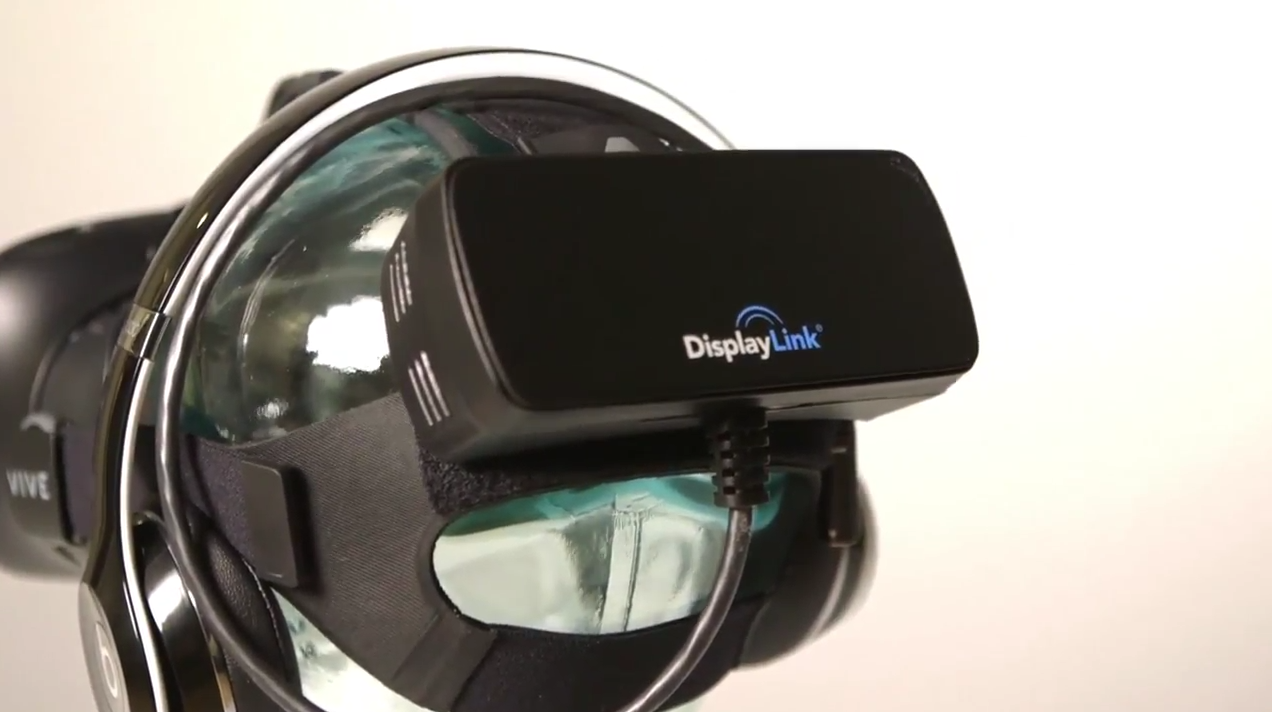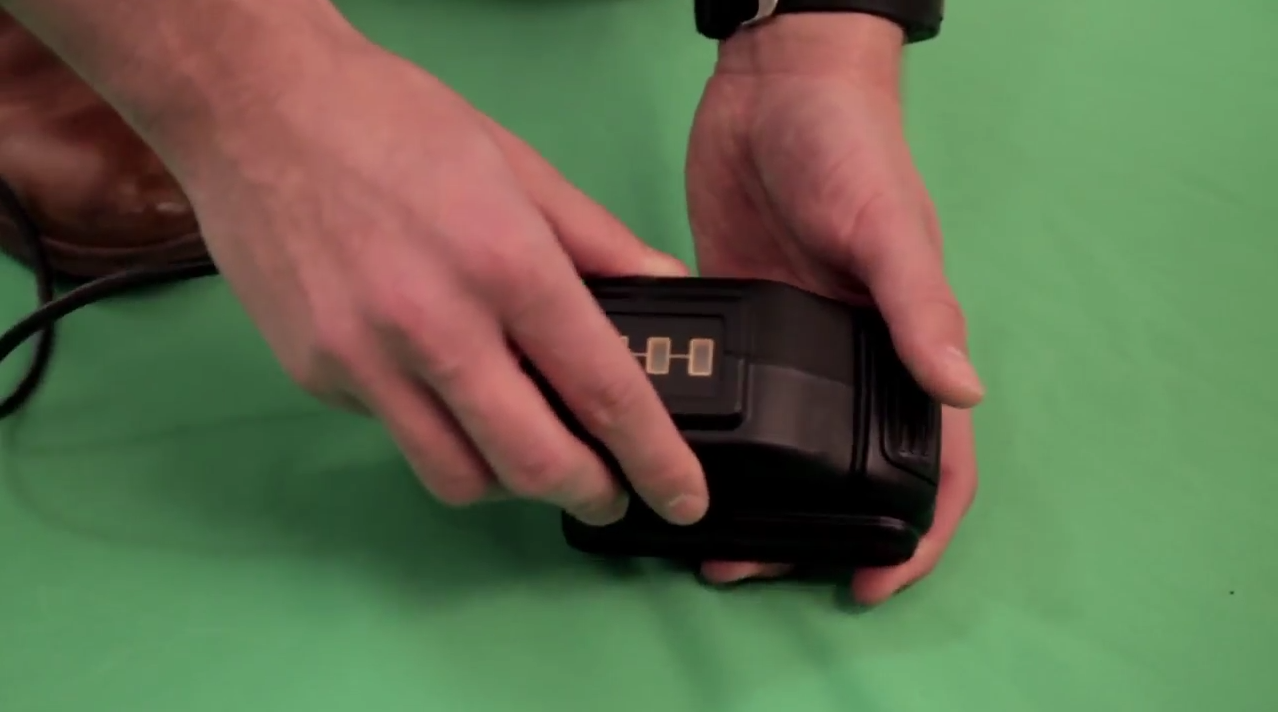DisplayLink Introduces Wireless Technology For First, Second, Third Generation VR HMDs
During CES 2017, DisplayLink announced and showcased a wireless video and data transmission system designed to scale for future HMD generations with higher resolution and higher refresh rate displays.
The first generation of virtual reality hardware graced us with multiple high-end VR systems that will blow your mind, but they are far from perfect. Critics and skeptics alike decry the long, bulky cable that extends from your PC to the headset.
The cables introduce unwanted wear and tear points. If you’re not careful, it’s easy to trample your cable while gaming, which can cause damage to your expensive equipment. Worse still, the tether, especially on HTC’s Vive system (which lets you move around somewhat freely), is a tripping hazard that some people, understandably, don’t want to deal with.
We can all agree that cutting the cord from the equation will improve the VR experience, but there’s a reason that HTC/Valve, Oculus, Sony, and OSVR went with wired solutions for their headsets. Wireless transmission traditionally introduces latency, which is the biggest enemy of virtual reality. A comfortable VR experience requires a high frame rate and low latency, and wireless technology that could keep up with the needs of high-end VR HMDs didn’t exist while the current crop of headsets was in development.
Today, the story has changed. If you want to cut the cord today, you can do it with a backpack computer from MSI or Zotac, but those options don’t really cut the cord—they just add more weight to the equation by strapping everything to your back.
Wireless transmission from the PC to your HMD is a better solution. There are several companies and groups working to make wireless HMD solutions a reality. In fact, by our count, DisplayLink’s system makes it no less than seven teams trying to develop wireless VR.
The first inkling of a working wireless VR HMD came to us in March 2016, from Neil Schneider at the Immersive Technology Alliance. Optima gave Schneider access to an early prototype wireless VR HMD from Optoma, and he shared some of the details. We haven’t heard anything else from Optima since the initial reveal, though.
Get Tom's Hardware's best news and in-depth reviews, straight to your inbox.
In August, during IDF 2016, Intel revealed a wireless VR system based on WiGig technology that could end up in future third-party VR products. Intel’s system is only a prototype in its early stages of evaluation, though.
In early September, we caught wind of the first wireless upgrade system for HTC’s Vive. Quark VR revealed a sneak peak of its upcoming wireless system that it’s developing with the help of Valve. Quark VR said it would have more to say about its solution near the end of 2016, but it hasn’t provided an update since August.
Quark VR may have been spooked away from the market. Two months after the company announced its wireless solution HTC announced a partnership to sell a wireless system from a company called TPCast, based out of China, alongside the HTC Vive. The TPCast wireless system replaces the standard tether cable for the Vive and will be available in Q2 2017.
Days after HTC announced TPCast’s wireless Vive upgrade system, MIT chimed in with its own wireless VR solution. MIT’s researchers developed a process to use millimeter waves, which can transmit “billions of bits per second.” Millimeter waves are directional, so MIT’s solution includes a system that enables the transmitter to track your movement within room-scale VR.
At least three more wireless solutions were announced during CES 2017, and the new options show some love for Oculus Rift owners. KwikVR revealed a 5GHz wireless upgrade solution that should work with any VR HMD, and Rivvr announced a similar product.
The products above are interesting and have us excited for the near future, but DisplayLink’s forthcoming wireless solution is perhaps the most interesting because it has the most potential for future HMD generations. DisplayLink’s designed its system to scale up to support higher resolution and higher refresh rate displays. The company is even preparing for the day when we have HMDs with dual 4K 120Hz HDR displays.
“VR is changing the way we interact with computers and the way we visualize information, yet a totally immersive experience for either gaming or business isn’t possible while worrying about cables. Rapid movements, such as turning or crouching, could cause damage to equipment and literally tie the user up in knots,” said John Cummins, SVP Sales and Marketing. “VR is opening a whole new chapter in visual immersion, but limits on cable connection, latency and bandwidth bring large challenges which DisplayLink is uniquely positioned to solve. DisplayLink’s industry-proven compression technology and ultra-low latency enable a fully immersive experience, and we’re excited to be showcasing the first concept at CES.”
DisplayLink’s wireless VR HMD system works with current generation headsets with dual 1080x1200 90Hz displays, but the current generation of DisplayLink’s wireless system can drive far more pixels than that. DisplayLink reckons that its current chipset, DL-6000, can drive two 4K displays at 60fps. The final product will employ DL-8000 chips that can pump out double the framerate.
Today’s VR HMDs demand roughly 6Gb/s of data through the tether. DisplayLink’s solution can handle up to 24Gb/s with as little as 2ms of added latency. The company said that with that amount of bandwidth, it’s wireless solution can drive two 4K displays at up to 120 frames per second with enough left over to include High Dynamic Range color information. DisplayLink believes its solution is viable for the next two VR HMD generations.
DisplayLink’s VR solution employs a 60GHz radio system with a beam-steering antenna, which sounds similar to MITs solution, and the chipset offers sub-3ms latency. But the magic of DisplayLink’s wireless solution rests in the company’s compression system, not the hardware. DisplayLink said its compression system “can maintain the resolution, quality, and frame rates” necessary to deliver comfortable VR experiences, “with no discernible increase in latency.”
DisplayLink didn’t discuss the price of the system, but the company said it is “in discussion with manufacturing partners to bring a commercial product to market in H2’17,” so we expect to hear more details in the coming months.
| Feature | Specification |
|---|---|
| High Resolution | Supports Gen 1 headsets (2160 x 1200) 90 fps with roadmap to 4K 120 fps and high dynamic range (HDR) for Gen 2 and Gen 3 products |
| Excellent Quality | No visible motion or compression artifacts |
| Low Latency | Typical sub frame of 2-3ms |
| Wireless | 60 GHz radio with beam-steering active antenna |
| Battery Powered | 2-hour operation from standard pack (head or belt mounted) |
| Standard Interfaces | - HDMI or DisplayPort for forward video path |
| - USB 2/USB 3 for camera and sensor back channel | |
| Silicon Available | The DL-8000 range of chips and associated reference designs are available for sampling to lead customers. |
Kevin Carbotte is a contributing writer for Tom's Hardware who primarily covers VR and AR hardware. He has been writing for us for more than four years.
-
Jeff Fx Nice to have another wireless option coming, but stepping on the cord and damaging it or tripping is only possible if you leave it on the floor to be stepped on, rather than building a proper VR space. Hang it from the ceiling, and use a retracting clothesline to keep the wire out of your way. This goes a lot better with the new Vive cable, so you don't need much force to keep it off the ground.Reply -
alidan Reply
doesnt matter what he likes or not, many places cover holes from pictures or in the ceiling as not the occupants fault... forget the name what its classified as.19134598 said:@Jeff I'll bet my landlord would just love me drilling holes in his ceiling.
but at the same time, even if you own the house, thats not an option for most people, a vr space. -
Jeff Fx Reply19134598 said:@Jeff I'll bet my landlord would just love me drilling holes in his ceiling.
As long as you spackle the holes when you leave, a sane landlord won't care. -
Jeff Fx Reply
Lots of houses have a front room and a living room. Giving up one of them for a VR room is a pretty good trade if you're healthy enough for active gaming. My large VR space is in an apartment. I don't need a dining room, so the dining room became the TV room, and the living room became the VR room.19134808 said:
doesnt matter what he likes or not, many places cover holes from pictures or in the ceiling as not the occupants fault... forget the name what its classified as.19134598 said:@Jeff I'll bet my landlord would just love me drilling holes in his ceiling.
but at the same time, even if you own the house, thats not an option for most people, a vr space.
It's a break from tradition, but I can do a lot more in a VR room than in a living room, and I now get a lot more exercise than I used to, and spend a lot less time sitting down. -
gopher1369 Good luck getting that idea past my wife! Serious answer: different priorities here, I think sitting down at a dinner table together as a family and eating together is more important than VR.Reply
-
WFang All these talks about the wireless interfaces, they don't specifically mention how the non-video portions of the data stream get incorporated. Tracking info, audio, web-cam (well that one is video) back to the host computer, etc. I'm guessing those signals are bundled in on the 'uplink' side of things and just not mentioned?Reply -
chicofehr If you have a friend who lives on a farm or acreage with an empty barn/garage/shed etc. then set it up there :P lots of room. Just make sure to download the games you want before bringing computer there as internet would be a problem.Reply -
bit_user Replythe magic of DisplayLink’s wireless solution rests in the company’s compression system
I'm gonna say "told you so".
I wonder if they can get any cost reductions on the beam steering antenna, if they integrated it with the VR system's existing tracking facility.



